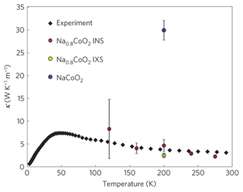Neutrons help understand the origin of thermoelectric properties in sodium cobaltates

Thermoelectric materials, which can generate electricity from waste heat or be used as solid-state refrigerators, could play an important role in a global sustainable energy solution. Such a development involves identifying materials with a higher thermoelectric efficiency than currently available. This is a major challenge given the conflicting combination of material properties that are required.
An international group led by Prof. Jon Goff from Royal Holloway, University of London, has used a combination of experimental studies of phonon dispersions together with DFT calculations to obtain new insight into the factors that control thermal conductivity in the multi vacancy cobaltate material Na0.8CoO2.
Thanks to a combination of Inelastic Neutron Scattering (INS) and Inelastic X-ray Scattering (IXS) experiments, it was possible to directly observe an Einstein-like rattling mode at low energy, involving large anharmonic displacements of the sodium ions inside multi-vacancy clusters. This rattling mode lowers thermal conductivity ? by a factor of six compared with vacancy-free NaCoO2. In particular, INS measurements performed on a relatively large crystal using the triple-axis spectrometer IN8 at the Institut Laue-Langevin allowed the group to determine the lattice contribution to the thermal conductivity as a function of temperature in the square tri-vacancy phase (see Figure). Instead of observing the characteristics expected of a phonon glass electron crystal, the group discovered that it is the change to the phonon dispersion from the rattling modes that contribute primarily to the suppression of ?.
By quantitatively accounting for the suppression of ? for this class of materials, the results of this work will guide the design of the next generation of materials for applications in solid-state refrigerators and power recovery.
Provided by Institut Laue-Langevin




















